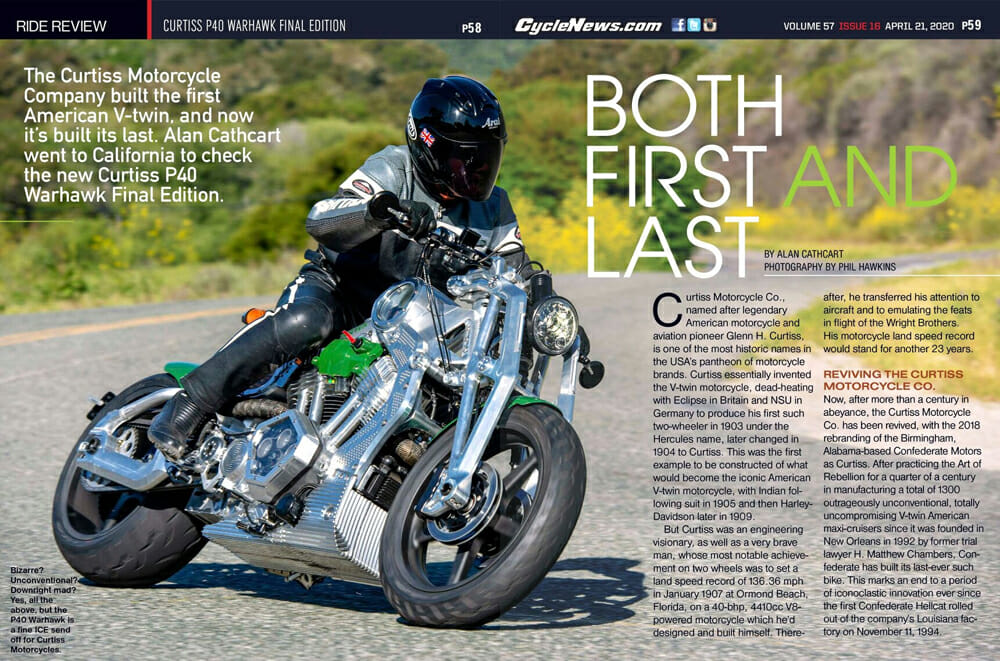Alan Cathcart | April 27, 2020
The Curtiss Motorcycle Company built the first American V-twin, and now it’s built its last. Alan Cathcart went to California to check the new Curtiss P40 Warhawk Final Edition.
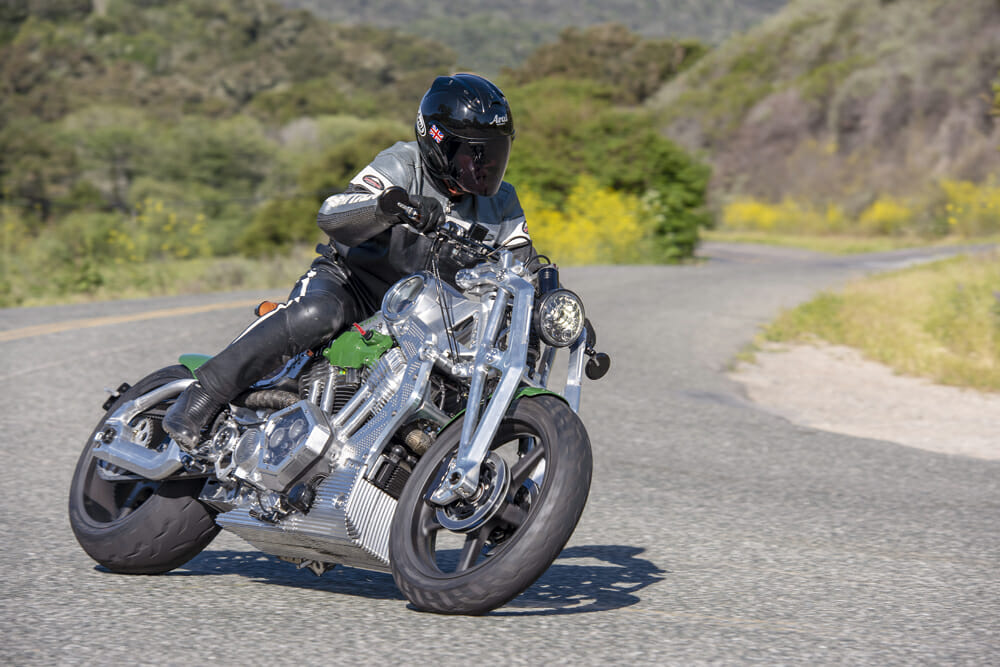 Bizarre? Unconventional? Downright mad? Yes, all the above, but the P40 Warhawk is a fine ICE send off for Curtiss Motorcycles.
Bizarre? Unconventional? Downright mad? Yes, all the above, but the P40 Warhawk is a fine ICE send off for Curtiss Motorcycles.
Photography by Phil Hawkins
Curtiss Motorcycle Co., named after legendary American motorcycle and aviation pioneer Glenn H. Curtiss, is one of the most historic names in the USA’s pantheon of motorcycle brands. Curtiss essentially invented the V-twin motorcycle, dead-heating with Eclipse in Britain and NSU in Germany to produce his first such two-wheeler in 1903 under the Hercules name, later changed in 1904 to Curtiss. This was the first example to be constructed of what would become the iconic American V-twin motorcycle, with Indian following suit in 1905, and then Harley-Davidson later in 1909.
But Curtiss was an engineering visionary, as well as a very brave man, whose most notable achievement on two wheels was to set a Land Speed Record of 136.36 mph in January 1907 at Ormond Beach, Florida, on a 40-bhp, 4410cc V8-powered motorcycle which he’d designed and built himself. Thereafter, he transferred his attention to aircraft and to emulating the feats in flight of the Wright Brothers. His motorcycle land speed record would stand for another 23 years.
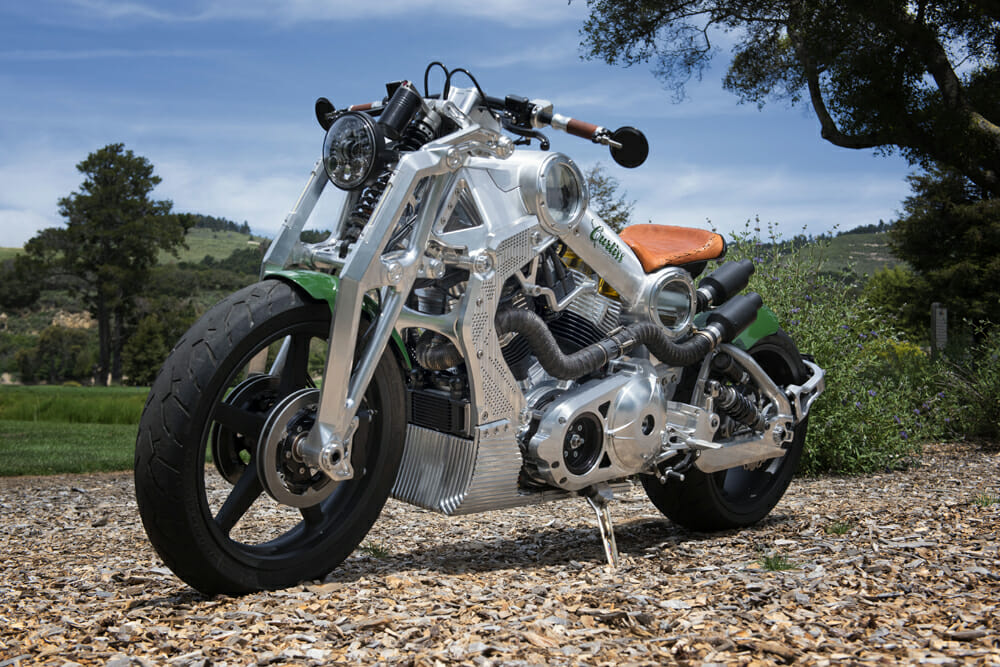 Billet aluminum for days and days and days. Just look at how the monocoque chassis does double and triple duties.
Billet aluminum for days and days and days. Just look at how the monocoque chassis does double and triple duties.
Reviving The Curtiss Motorcycle Co.
Now, after more than a century in abeyance, the Curtiss Motorcycle Co. has been revived, with the 2018 rebranding of the Birmingham, Alabama-based Confederate Motors as Curtiss. After practicing the Art of Rebellion for a quarter of a century in manufacturing a total of 1300 outrageously unconventional, totally uncompromising V-twin American maxi-cruisers since it was founded in New Orleans in 1992 by former trial lawyer H. Matthew Chambers, Confederate has built its last-ever such bike. This marks an end to a period of iconoclastic innovation ever since the first Confederate Hellcat rolled out of the company’s Louisiana factory on November 11, 1994.
That’s because this maker of unique motorcycles has not only adopted the Curtiss name but also abandoned the use of ICE/internal combustion engines in its products, in favor of concentrating 100 percent on producing an eclectic array of electric motorcycles. The first of these, the Curtiss Hades designed by J.T. Nesbit—creator of the iconic Confederate Wraith and final-series Hellcat models—will be unveiled in June (coronavirus pending) at the Glenn Curtiss Museum in his home town of Hammondsport, NY, with deliveries presently scheduled to start before the end of 2020, according to President/CEO Matt Chambers.
So, it’s goodbye to Confederate and hello to Curtiss—but the Art of Rebellion isn’t forgotten, not quite yet. For to bridge the period between the two brands, as well as to keep his assembly workers occupied while his R&D team completes development of the Hades, Chambers has celebrated the return of the Curtiss brand to the marketplace with a final farewell to the kind of motorcycles his company has been building for the last quarter-century. And he also pays homage to the man responsible for inventing their format in the first place.
This explains the creation of the Curtiss P40 Warhawk (named like all Chambers’ products after a WW2 military aircraft), which made its debut in 2018. Since then, 13 examples have been built and delivered for $105,000 each. Now the Birmingham factory is assembling a further Final Edition series of seven such bikes, at the much-reduced price of $75,000 each.
“After that, we will no longer build any more motorcycles which need a spark to light the motor,” says Matt Chambers. “Our factory will be 100 percent devoted to manufacturing electric products.”
The Curtiss Warhawk follows the same overall design format as the final run of Confederate motorcycles, which ended with another 13-off model run, the FA-13 Bomber Combat built in 2016-2018, retailing for $155,000 each.
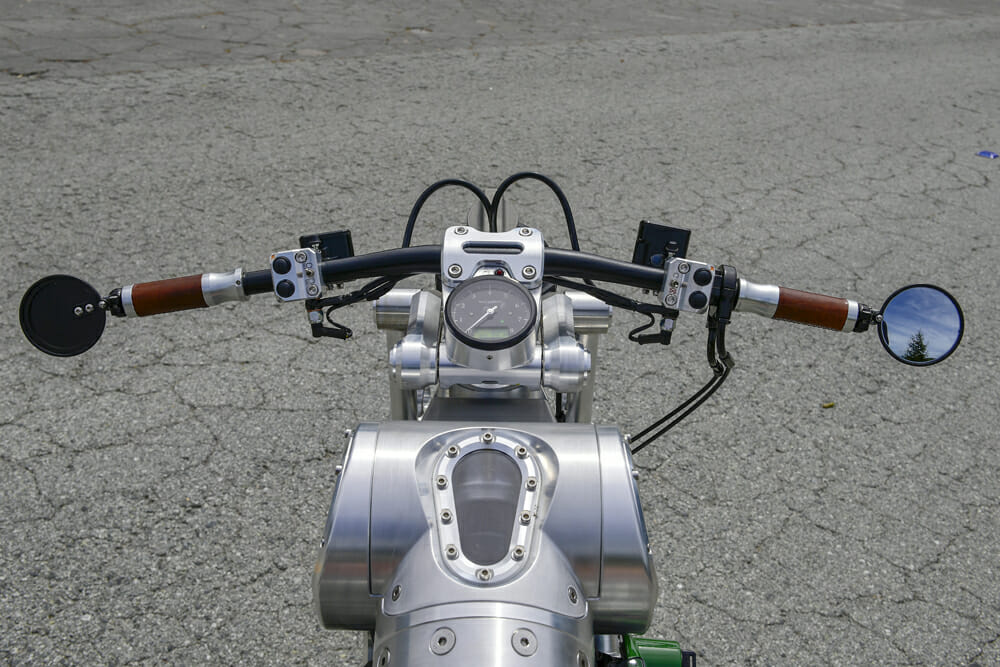 Mission control for the P40. Minimal, tough, angry. Just like the rest of the bike.
Mission control for the P40. Minimal, tough, angry. Just like the rest of the bike.
Bomber Branding for the Warhawk
Its Bomber genesis means the Warhawk is built around a similar seven-inch (178mm) diameter fuselage comprising its spine frame, its component parts CNC-machined from solid 6061-T6 aluminum billet, then duly bolted together to create a monocoque chassis holding the V-twin motor, which is rigidly mounted as a fully-stressed frame component.
It’s a true monocoque because it indeed also comprises the fuel tank, carrying four gallons of gas in a receptacle within the fuselage, which extends downwards under the seat. There are five sight glasses incorporated in the chassis, with the upper trio allowing you to peer into the airbox incorporated into its upper section, while the lower pair lets you monitor the level in the fuel cell. Imagine the legendary Isle of Man TT-winning John Player Norton racer’s aluminum monocoque chassis, but CNC-machined from solid billet and then bolted together, rather than fabricated via a TIG-welder, as the Norton was. That’s what the Warhawk represents, albeit carrying a very different kind of twin-cylinder OHV pushrod engine than the Norton’s relatively puny 75-bhp 750cc parallel-twin such motor.
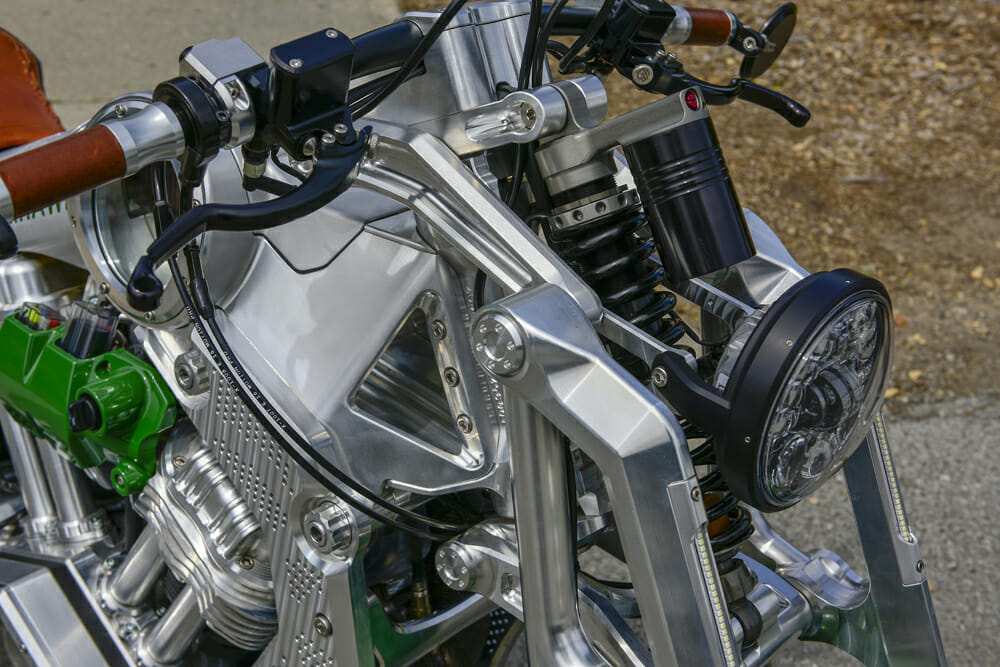 The front suspension is a girder-style fork similar to the type favored by John Britten and his V1000.
The front suspension is a girder-style fork similar to the type favored by John Britten and his V1000.
Like previous Confederate models, the Warhawk is powered by an air/oil-cooled 2163cc triple-camshaft S&S X-Wedge OHV 56.25° V-twin motor with two valves per cylinder, a forged one-piece crank, and hefty flywheels. The engine’s architecture was tailored explicitly for this motorcycle by the Wisconsin-based company, with its crankcases also carved from solid 6061 aluminum billet, and featuring dedicated attachment points to suit the Warhawk’s monocoque frame design.
This mechanical package also incorporates Curtiss’s own stacked-shaft five-speed gearbox with Andrews gears—a format which the Company Formerly Known As Confederate was the first to employ in 1995, two years before Yamaha supposedly invented it on the R1.
This is mounted in a fully-machined transmission housing bolted directly to the back of the X-Wedge motor, to create a tight unit-construction entity. A short 1 3/4-inch-wide belt primary drive is mounted on the left, matched to a hydraulically-operated Bandit dry clutch, and with chain final drive on the right rather than by belt, because of the massive amount of torque on tap. The Warhawk’s version of the motor has been tuned to deliver serious horsepower and immense grunt in a fully street-legal package, and then some, for according to Matt Chambers, it features a little more performance than before, in a subtly revamped package.
“This is the ultimate high-performance V-twin motorcycle, as befits the first and last such model to carry Mr. Curtiss’s name for the first time in 110 years,” says Matt Chambers. “We have six horsepower more from this billet motor which runs stronger than before, and is now happy to pull to 6200 rpm, 200 revs more than previously. That’s because we have a new camshaft design which enhances top-end performance—yet we have the same highly developed torque available as before, peaking very low down. So, we have more on one hand, without losing any on the other.” The 156 hp at 5500 rpm produced at the rear wheel by the Warhawk’s X-Wedge engine is four percent up on the Bomber’s tune, says Chambers, plus there’s the same truly humongous 165 ft-lb of torque on tap at just 2000 rpm. The era of the great American muscle bikes may be ending, but they won’t be forgotten—especially not by anyone fortunate enough to have ridden one.
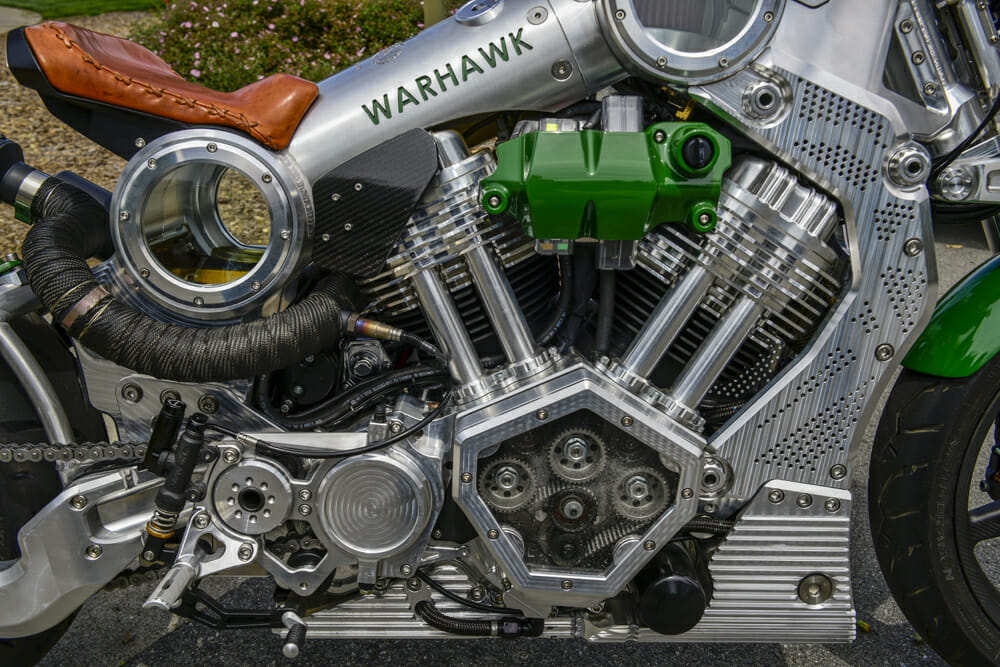 The P40’s S&S motor produces a stonking 165 ft.-lbs. of torque.
The P40’s S&S motor produces a stonking 165 ft.-lbs. of torque.
The Warhawk Architecture
The Final Edition of the Warhawk has also been revamped architecturally, too, with Curtiss in-house designer Jordan Cornille subtly enhancing the overall appearance, with the freer-flowing Burns stainless-made exhausts that are partly responsible for those extra horsepower numbers. These now bend their way rearwards inside your legs, albeit heavily wrapped in heat-insulating (well, partially anyway) cord, before ending in a pair of very plain, anonymous-looking mufflers—sorry, Matt, but these just look cheap, quite out of keeping with the rest of this gorgeous-looking set of wheels. “Yes, we need a better silencer—they’re not very good to look at, are they?” admits Chambers, “But they sound so good, especially not having a crossover pipe, which gives an angry edge to the exhaust note. Function beats form, I’m afraid!”
Replacing the exhausts beneath the dry-sump S&S motor is a larger oil tank than that previously carried higher up. This not only allows it to contain an extra one-and-a-half quart of lubricant, which according to Chambers makes the engine run that much cooler but also allows a two-inch lower ride height for the complete motorcycle versus the Bomber, without sacrificing ground clearance, while the rear end has been raised half an inch to sharpen up the steering. That’s partly because the 19-inch front/17-inch rear wheels of the Bomber have been replaced here by a pair of 18-inchers, both BST carbon wheels made in South Africa to Curtiss spec, here carrying Pirelli Night Dragon rubber.
Up front as before is a double-wishbone parallelogram fork, with tubular aluminum struts and a direct-action RaceTech monoshock that’s fully-adjustable for high and low-speed compression and rebound damping, in offering 4.35 inches of wheel travel. That raised rear end consists of a fabricated aluminum swingarm with a cantilever RaceTech monoshock, again offering two-speed compression and rebound damping, and 5.50 inches of wheel travel that’s downright rangy by cruiser standards. The ultra-laydown shock location, in theory, at least gives a progressive rate of rear suspension response, despite there being no link. Wheelbase is a rangy 62.52 inches.
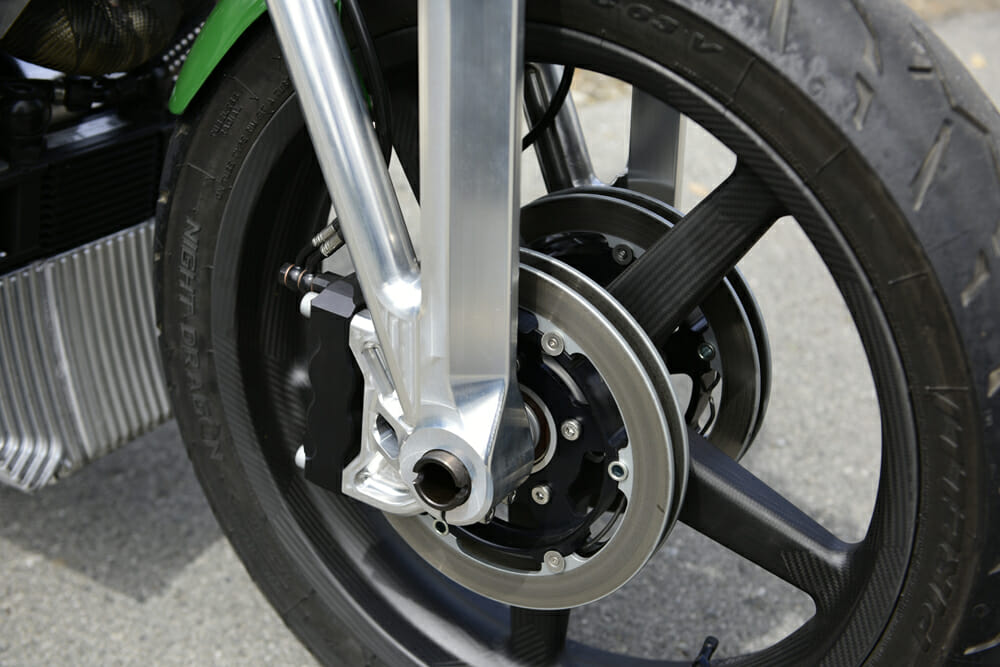 Yes, quadruple front brake discs are fitted to the Warhawk.
Yes, quadruple front brake discs are fitted to the Warhawk.
Like the Bomber, the Warhawk carries similar new-generation leading-edge French brakes made in cast iron, with no less than four Beringer 230mm stainless steel Aeronal floating front discs doubled up in two pairs and gripped by four-piston Aerotec radial calipers employing special sintered metal pads. The brakes have to stop a bike weighing 545 pounds with oil and a full 3.75 gallons load of fuel, resulting in a 48/52 percent distribution front to rear. There’s another pair of 230mm Beringer discs at the rear, gripped by a third four-piston radial caliper. But, why no ABS? “As a lame duck model, there was no point in making the investment needed to develop a system for the Warhawk,” says Matt Chambers. “But we’ll have a full ABS brake package on the Curtiss electric models by the time they start production.”
Curtiss P40 Warhawk Final Edition Testing
Though production of the Curtiss Warhawk began in May 2018, so far nobody outside the company other than a customer has been allowed to ride one. My chance to become the first such person came in Northern California, along the glorious winding roads with their turns interspersed with fast open stretches running inland from Carmel towards Salinas, just a few miles from the Laguna Seca racetrack. It was there I discovered that, once again, any product of the Alabama factory has improbably good-handling by cruiser standards, and positively urges you to ride it hard. As always, in such circumstances, I was all too easily led!
As soon as you straddle the Warhawk, you realize it has a subtly different riding position than its Bomber cousin, slightly higher. The improbably comfy, plushly-padded but minimalist seat’s 29.5-inch height is half an inch taller than before, and your feet are a little further back, in what is a true café racing stance which feels rational. The flat drag-style handlebar dictates that you lean forward slightly to grab the grips, with your feet finding the relatively rear-set footrests easily without those new high rise exhausts grazing your inside leg measurement—though they do give off quite a bit of heat despite the cord wrap.
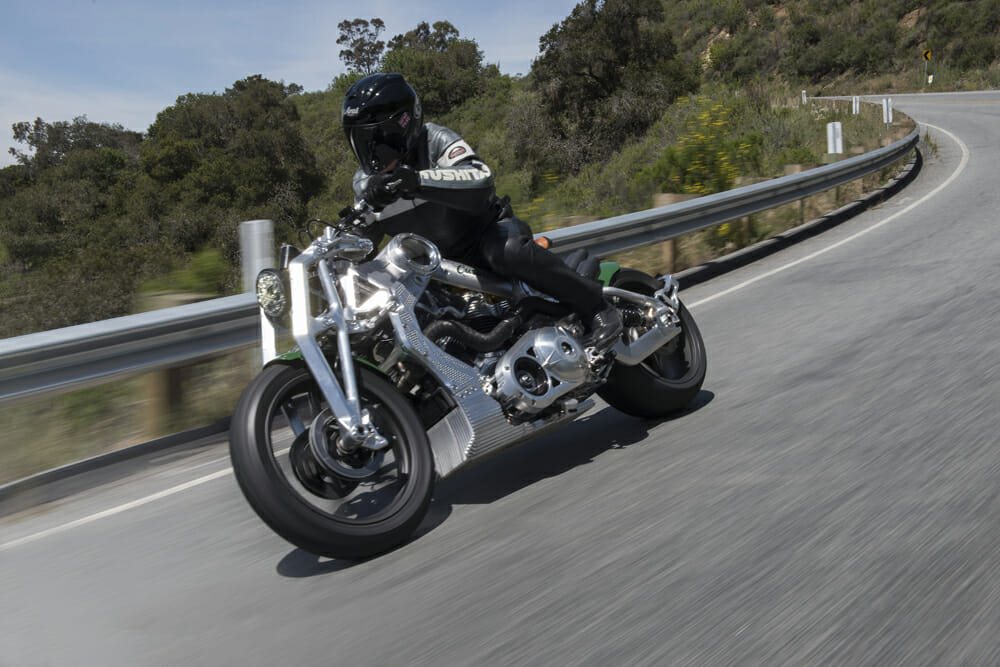 Despite the rather wide and flat rear tire, the P40 Warhawk steers surprisingly well.
Despite the rather wide and flat rear tire, the P40 Warhawk steers surprisingly well.
Because the whole motorcycle is essentially no wider than the massive 240/45-VR18 Pirelli Night Dragon rear tire, despite its size, the Curtiss feels responsive and agile. That’s partly thanks to the reduced gyroscopic effect of the BST carbon front wheel and downsized quartet of Beringer brakes helping speed up the steering so that you don’t need to give the flat ’bar more than a light tug to make the Warhawk switch direction easily from side to side.
Despite the long 62.52-inch wheelbase and that fat rear tire, the Warhawk is improbably light-steering, albeit lazily so thanks to the wheelbase and conservative steering geometry, with a 27.5° rake to the machine-hewn girder fork, and 106mm of trail. Even though you can’t grip the spine frame between your knees, you feel pretty much at one with a bike that steers and handles pretty capably. It felt super-stable when braking downhill into a bend, as the girder-style fork similar to the type favored by John Britten, here machined from solid aluminum to hold down the unsprung weight, kept right on working at damping out road rash as I trail braked into the turn on the angle. The RaceTech shocks had been set up to give optimum damping and excellent ride quality for a person of my weight, and the Warhawk felt pretty confidence-inspiring in the way it steered. Mr. Curtiss would have approved.
The grippy front Pirelli Night Dragon encourages you to keep up turn speed, especially as there’s more ground clearance on the Warhawk, with the exhausts moved upstairs for extra clearance. The fact that the fat rear tire is mounted on a slightly wider-than-usual 8.5-inch BST carbon rim spreads the rubber out more, resulting in a flatter profile delivering a more progressive feel.
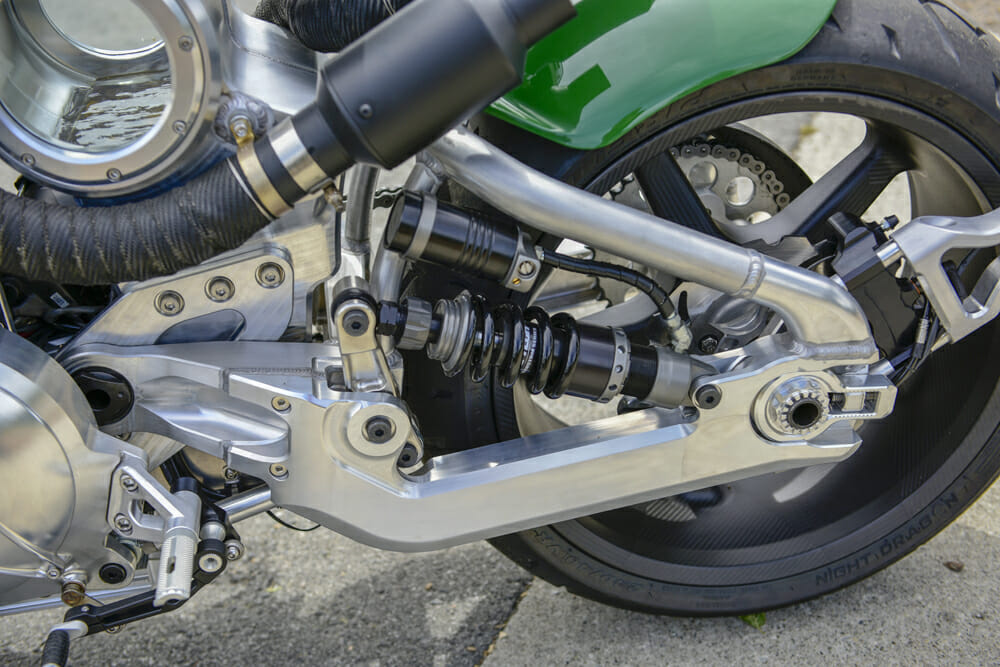 The aluminum swingarm with the cantilever RaceTech monoshock offers two-speed compression and rebound damping.
The aluminum swingarm with the cantilever RaceTech monoshock offers two-speed compression and rebound damping.
Firing up the X-Wedge powerplant is instant, after turning the ignition key down by your right knee and flicking the tiny kill switch on the right switchbox that seems disproportionately dainty for such a meaty musclebike. Just thumb the starter button, and it cranks immediately into life first time, every time—though you must be ready for the earth to move under the sustained thunder emitted by twin mufflers.
That easy start-up by Big Twin standards comes because S&S has fitted the motor with its Easy Start cams, which reduce cranking compression via an innovative feature. Each of the two exhaust cam lobes is equipped with a spring-loaded compression release lobe on the heel of the cam, at the point where the valve would typically be fully closed. This lobe holds the exhaust valve slightly open at cranking speed, which releases some of the compression, making the engine much easier to turn. Once it starts firing, revs increase until at 800 rpm the compression release lobe is centrifugally retracted, and the exhaust valve closes fully as part of the normal engine cycle. The engine now runs normally, with full compression. Clever!
When that happens, the Warhawk’s engine bursts into life with a satisfyingly meaty peal of thunder from the exhaust, settling to a 900rpm idle that’s devoid of the clackety rattles and shakes of some other American air-cooled pushrod V-twins. Though S&S declines to fit any vibration-sapping counterbalancers to it, the triple-camshaft X-Wedge motor is pretty smooth by air-cooled V-twin standards, with no undue vibration despite being solid-mounted for extra chassis stiffness.
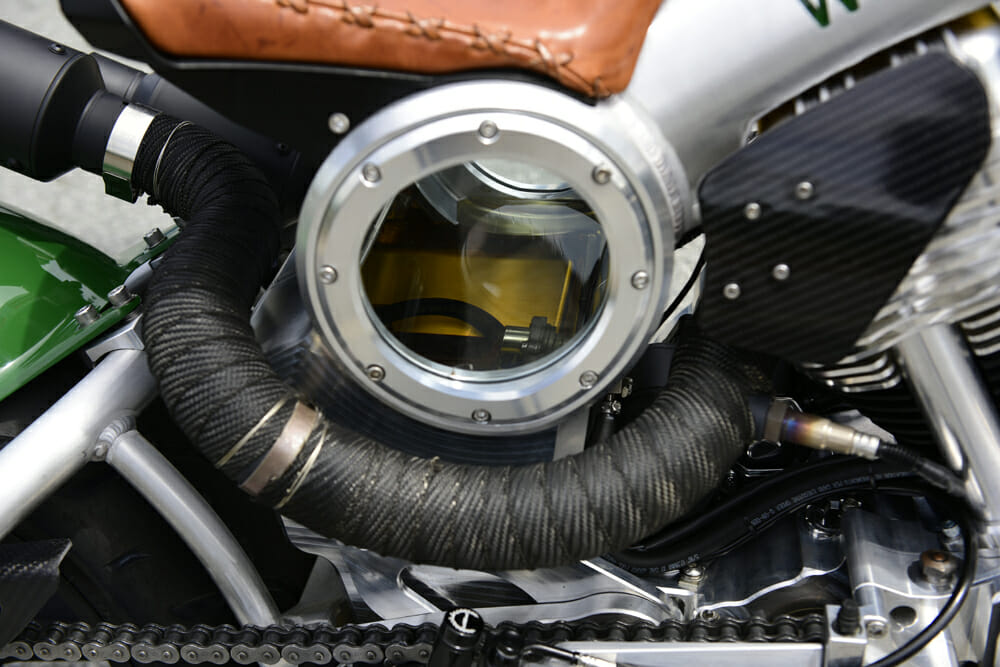 Checking the fuel level has never been so easy!
Checking the fuel level has never been so easy!
Thanks to the refined fueling delivered by the Delphi EFI, it’ll pull cleanly off idle with acres of grunt, and truly impressive acceleration. Just crack the throttle open in almost any gear you care to throw at it, and the Curtiss surges forward irresistibly, but controllably. Engine mapping is ideal, without too vivid a throttle response, and wheelies aren’t an issue because of the long wheelbase. That great acceleration comes thanks to the massive amount of torque on tap at almost any engine speed, which peaks at just 2000 rpm, but holds hard and strong all the way through to the new 6200-rpm rev-limiter, which because of those oodles of torque you have no business ever approaching.
The shift action of the Bomber’s five-speed Confederate gearbox with Andrews gears is quite positive, swapping ratios smoothly while allowing you to find neutral quite easily at rest. But with so much torque on tap, two of those five ratios remain completely superfluous—you can start off from rest in third gear without slipping the clutch much, and the Curtiss will go almost anywhere in top gear, with hugely impressive roll-on performance from virtually any revs.
The quartet of leading-edge Beringer 230mm cast iron floating front discs work brilliantly well with heaps of feel in stopping the Curtiss from the high speeds it’s so fully capable of reaching. This was proved by Confederate customer Jim Hoegh establishing a new Land Speed Record on his Hellcat at the Bonneville Salt Flats in 2014 at 172.211 mph (277.146 km/h) in the APF-3000 category for unstreamlined, naturally aspirated, pushrod V-twin engines above 2000cc, with a one-way pass of 176.458 mph.
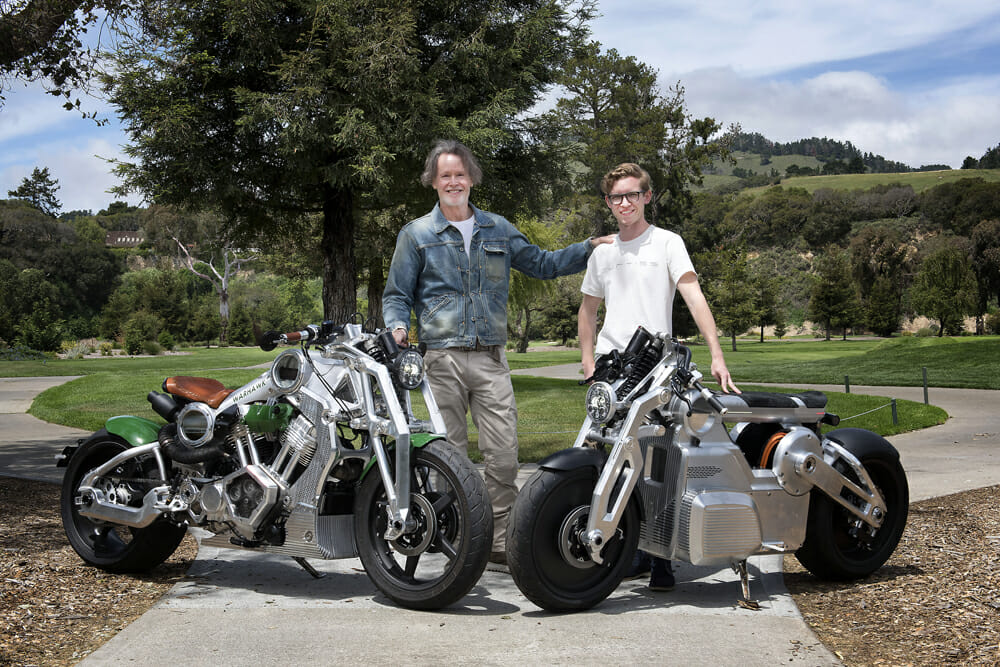 Curtiss owner Matt Chambers (left) with young designer Jordan Cornille, who will take Curtiss Motorcycles forward with the electric platform.
Curtiss owner Matt Chambers (left) with young designer Jordan Cornille, who will take Curtiss Motorcycles forward with the electric platform.
“I believe this Curtiss Warhawk is the best internal combustion-engined motorcycle I’ve ever made,” says Matt Chambers, “and I’ve been making them for almost 30 years. It seems an appropriate way to say farewell as we turn the page and focus totally in the future on our next-generation electric models. Because this Final Edition also resonates the fact that Mr. Curtiss invented the American V-twin—but then laid it to rest as far as he was concerned in favor of striking off in a new direction, namely aviation. Well, we’re doing the same, though staying on two wheels but with electric propulsion. Either way, it’s an epiphany—and we can only hope to be just a tiny bit as successful with our new direction, as he was with his!”
Amen to that!CN
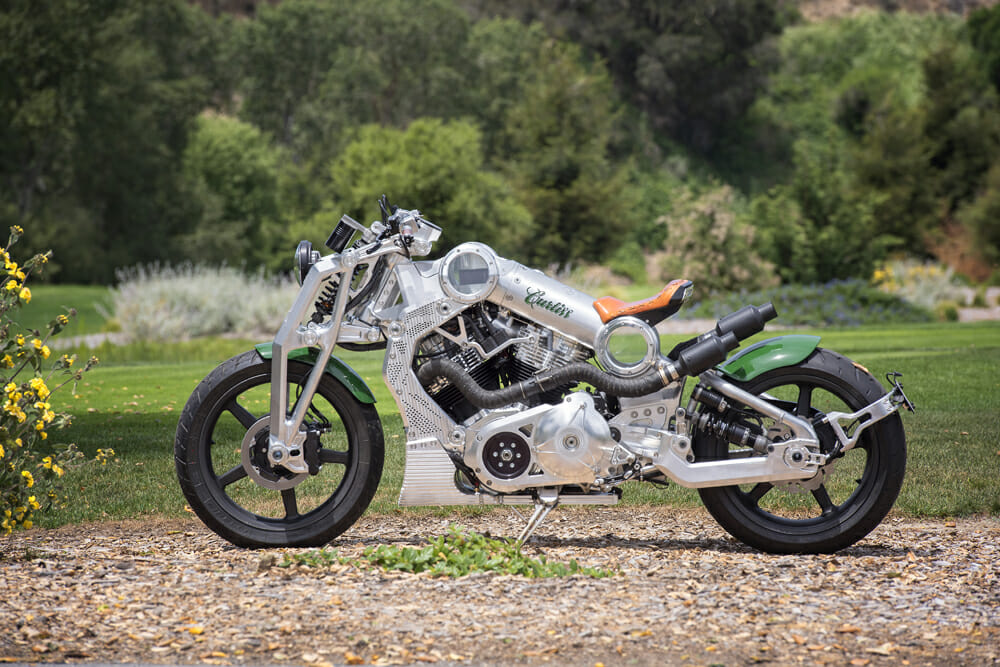
Curtiss P40 Warhawk Final Edition Specifications
|
| MSRP: |
$75,000 |
| Engine: |
Air/oil-cooled, triple-camshaft OHV, pushrod, dry-sump 56.25 4-valve V-twin 4-stroke, with one-piece forged crankshaft, toothed belt camshaft drive, and machined 6061-T6 billet aluminum crankcases |
| Displacement: |
2163cc |
| Bore x stroke: |
111.76 x 116.76mm |
| Power: |
156 hp at 5500 rpm |
| Torque: |
160 ft.-lbs. at 2000 rpm |
| Transmission: |
5-speed |
| Clutch: |
Wet multi-disc |
| Chassis: |
Machined modular aluminum monocoque, with 7.0 in. backbone containing fuel load |
| Front suspension: |
Double-wishbone parallelogram fork with tubular aluminum struts and direct-action RaceTech monoshock, fully adjustable |
| Rear suspension: |
Fabricated aluminum swingarm with cantilever RaceTech monoshock fully adjustable |
| Front-Wheel Travel: |
3.35 in. |
| Rear-Wheel Travel: |
5.50 in. |
| Front brake: |
4 x 230mm Beringer floating Aeronal cast iron discs with 2 x 4-piston Beringer radially mounted Aerotec calipers |
| Rear brake: |
2 x 230mm Beringer floating Aeronal cast-iron disc with 4-piston Beringer radially-mounted Aerotec caliper |
| Front tire: |
130/70R18 in. Pirelli Night Dragon on 3.50 in. BST carbon wheel |
| Rear tire: |
240/40VR18 in. Pirelli Night Dragon on 8.50 in. BST carbon wheel |
| Rake: |
27.5 |
| Seat height: |
29.5 in. |
| Fuel capacity: |
3.75 gal. |
| Weight (wet, claimed): |
545 lbs. |
